(Undo revision 122884 by 68.6.104.123 (talk)) Tag: Undo |
No edit summary Tags: Visual edit Mobile edit Mobile web edit |
||
| Line 39: | Line 39: | ||
Also notable are the time dilation effects experienced at higher speeds; an Earth-time voyage of 6.75 years seems significantly shorter at 0.7 times the speed of light. In accordance with Einstein's theory of relativity, from the crew's point of view it is only five years' travel due to [http://en.wikipedia.org/wiki/Time_dilation time dilation]. |
Also notable are the time dilation effects experienced at higher speeds; an Earth-time voyage of 6.75 years seems significantly shorter at 0.7 times the speed of light. In accordance with Einstein's theory of relativity, from the crew's point of view it is only five years' travel due to [http://en.wikipedia.org/wiki/Time_dilation time dilation]. |
||
| + | |||
| + | Big Chungus |
||
== Propulsion == |
== Propulsion == |
||
Revision as of 06:19, 3 March 2021
| ISV Venture Star | |||||||
|---|---|---|---|---|---|---|---|
| Machine Information | |||||||
| Created by | |||||||
| Used by | |||||||
| Type | |||||||
| Size |
| ||||||
| Speed |
0.7 C | ||||||
| Behind the scenes | |||||||
| First appearance | |||||||
The Interstellar Vehicle Venture Star (also known as ISV Venture Star, or simply ISV) is one of ten[1] interstellar spaceships that is part of a looping supply chain for the transport of supplies, equipment, personnel, refined ore, and data between planet Earth and the distant moon Pandora. Since it is designed to operate only in deep space, It never lands on Pandora's surface. If an ISV ever attempted atmospheric entry, it would break apart and burn up because of atmospheric friction and high gravitational forces. Instead, it sends smaller shuttle-like vessels, called Valkyries, to land on the moon's surface. The Venture Star arrives at Pandora after more than five Earth years in transit; the hundred-plus humans on board -- apart from the four man flight crew -- are in cryosleep for the entirety of the trip.[2]
Interstellar starships such as the ISV Venture Star require unobtanium in their manufacture, due to unobtanium's role in providing containment for antimatter-matter reactions.[3]
History
Predecessor and other ships
The ISV Venture Star is a Capital Star class ship. There was at least one predecessor to the ISV Venture Star and other Capital Star class ships, a ship that was four times as massive as the current design. It used cold superconductors (because no unobtanium was available when building it), which required much bigger radiators. The ISV Bradbury may be one of these. In total, there are 12 ships transporting cargo and crew between Pandora and Earth. Nine of them are Capital Star class ships of the same type as the ISV Venture Star.[3] The initial funding to build the ship was seen as a colossal risk by the RDA, but one that paid off thanks to their exclusive rights to mine unobtanium.[4]
Voyages
The Venture Star has been in operation for at least 77 years. The first ROVR landings on Pandora in 2084 were dropped from orbit by ISV Bradbury and Venture Star.[5] The ship has likely made several trips to and from Pandora in the intervening decades, including the 2148-2154 journey that brought Jake Sully to Pandora.
Capabilities
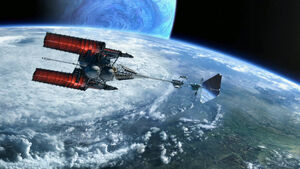
3D Version: red/cyan, cross-eyedThe ship offloads cargo as it orbits Pandora
The ISV Venture Star can travel from Earth to Alpha Centauri A (a distance of 4.37 light years[6]) in a timeframe of 6.75 years. It starts with a five and a half month long initial acceleration at 1.5 G to reach 0.7 times the speed of light. Then it continues at the same speed for 5.83 years before the engines or photon sail (depending on which way the ships are traveling) are used to decelerate the vehicle. The ship's deceleration phase also lasts for five and a half months at 1.5G.[3]
Also notable are the time dilation effects experienced at higher speeds; an Earth-time voyage of 6.75 years seems significantly shorter at 0.7 times the speed of light. In accordance with Einstein's theory of relativity, from the crew's point of view it is only five years' travel due to time dilation.
Big Chungus
Propulsion
The ISV Venture Star uses multiple types of propulsion, all of which are used over the course of an interstellar journey between Earth and Pandora. The Venture star has:
- Two matter-antimatter engines
- One photon sail
- One fusion PME (Planetary Maneuvering Engine).[3]
The photon sail is used for the outward acceleration phase to Pandora from Earth in the form of beamed photons from a solid state molecular laser from Earth. The ship's matter-antimatter engines are used for the deceleration phase on approach to Pandora, and the ship then coasts the last few million kilometers. The sequence is reversed for return to Earth. When close enough to Pandora or Earth, the Planetary Maneuvering Engine is used to maneuver into a low delta-v orbit, from which it can launch Valkyrie shuttle craft to the surface.[3]
Matter-Antimatter engines
Interstellar Vehicles require a huge amount of thrust in order to reach the speeds that are needed for economic and (relatively) swift travel between solar systems and stellar bodies. Humans took roughly two centuries to create advanced and reliable matter-antimatter based propulsion systems.
An ISV has two matter-antimatter engines arranged symmetrically in a tractor configuration that pulls the ship behind them. They are angled slightly away from the body of the ship, a few degrees off the ship’s longitudinal axis, so their exhaust plumes bypass the ship’s structure. This results in a slight loss of thrust efficiency because the engines do slightly push toward each other. The lost thrust is deemed acceptable because the angling separates the body of the ship from the plume’s thermal radiation. Scientists considered placing the engines at the back instead, but the mass-savings advantage of a tensile structure outweighs the disadvantages of shielding. Since a very long truss is needed to separate the habitable section of the ship from the engines, which produce large amounts of radiation, such a structure would be prohibitively massive if it were a conventional space-frame truss designed for compressive loading. The carbon-nanotube composite tensile-truss creates the necessary stand-off distance at one-tenth of the mass. Essentially, it is a rigid, extremely strong tow cable with engines in the front and the "trailer" in the rear.[3]
The antimatter fuel (in this case anti-hydrogen), is contained by a magnetic field in a near-perfect vacuum in which it circulates as a high density cloud of atoms cooled to near-absolute-zero temperature. When antimatter and matter (normal hydrogen) are brought together, they annihilate and release an enormous amount of energy, which must be directed by an ultra-powerful magnetic field to form the exhaust plume. These photons of energy, although without mass, possess momentum, and their ejection provides the thrust to accelerate the ship. Additional thrust is obtained by injecting hydrogen atoms into the plasma before it leaves the engines. The exhaust flare is an incandescent plasma a million times brighter than a welding arc, and over thirty kilometers long. The plume is considered to be one of the most spectacular man-made sights in history.[3]
Structure
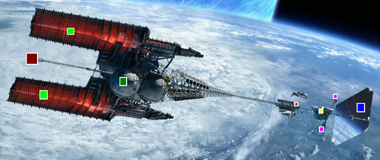
Engine radiator[3]
Fuel containers[3]
Likely solar sail attachment structure[7]
Valkyrie docking station and cargo bay[3]
Cryosleep chambers[3]
Crew areas[3]
The ship's primary structure (which could only exist in a micro-gravity environment) consists of the two side-by-side engines attached to a tensile-truss of carbon-nanotube composite. This connects the propulsion section to the payload section, which includes habitation modules for crew, the cryovaults for passengers, amnio tanks for the avatars, and the cargo section. Starting from the forward end:
- 1. Engines, propellant tanks, and radiators. The propellant tanks are spheres insulated for zero boil-off of the cryogenic hydrogen propellant. The radiators dissipate the heat of the engine section. After a deceleration or acceleration burn phase, the radiators will glow red-hot for 2 weeks because of the lack of convection cooling in a vacuum.
- 2. The tensile-truss that transfers the thrust of the two engines to the rest of the ship. Although thin, it is rigid enough to prevent the payload section from fishtailing caused by buildup of resonant frequency vibrations during acceleration and deceleration. The section of the truss adjacent to the antimatter engine nozzles is protected by a thermal shield of nearly perfect reflecting materials, to guard against the intense heat radiated from the exhaust plumes.
- 3. Cargo containers, arranged in four ranks of four modules each. The 16 modules are in turn composed of six cargo pods. Depending on the cargo bay configuration of the shuttle, it can hold the contents of two pods and 100 passengers in jump seats, or up to the contents of six pods and no passengers. A mobile transporter running on tracks can position a large robotic arm for transfer of the cargo modules to and from the trans-atmospheric shuttles.
- 4. Two Valkyrie TAVs (trans-atmospheric vehicles) docked to access tunnels. The tunnels connect to a pressurized tunnel that runs through the truss, and connects to the habitation section.
- 5. The habitation section consists of three large modules containing the cryovaults and amnio tanks. Inside each module is an open frame structure of advanced composites, with non-load bearing bulkheads made of foam composite. There is almost no metal used in the structure. This is to prevent galactic cosmic radiation from striking metal and producing secondary radiation particles. There are a number of airlocks for the crew, and portals for repair bots that look like high-tech mechanical crabs.
- 6. Immediately behind these three modules are the two on-duty crew modules, located at the opposite ends of a transverse truss. A pressurized tunnel runs through the truss, connecting the two units. During cruise mode, these modules can be rotated to create an artificial gravity for the on-duty crew. During acceleration and deceleration phases, the modules fold along the longitudinal axis of the ship. In this configuration, the gravity is created by the acceleration of the ship (so all decks and bulkheads are still correctly oriented to the gravity vector). The modules also provide centrifugal artificial gravity during the ISV’s one year orbit around Pandora.
- 7. At the far end of the structure is the mirror shield, which protects the ship from the intense light of the beamed power laser from Earth. This mirror is only a few molecules thick, but reflects light efficiently enough to prevent incineration of the habitable section of the starship.
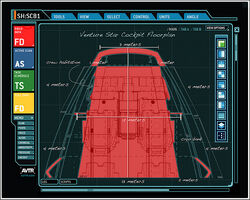
A deckplan of the cockpit
When acceleration is completed, the ship is rotated 180 degrees so that the mirror shield faces forward.[3] The shield performs another role, acting as a multilayer interstellar debris shield. Although intense magnetic fields are used to deflect stray gas molecules, the occasional dust grain requires a physical barrier. The shield is in multiple layers, spaced one hundred meters apart. Impact of a debris grain (traveling at a relative speed of 0.7C) with the first layer of the shield causes vaporization into a plasma. The spray of plasma particles strikes the second layer, and the impacts cause spalling from the back of the second layer. These particles are stopped by the third layer. A fourth layer acts as a backup in the unlikely event that something gets past the third layer. Once cruise speed is reached, this shield is detached and moved by small thrusters thousands of miles in front of the ship to improve survivability if a larger particle of debris is encountered.[3]
The largest component of the ship is not located on the primary structure. It is the “sail,” which receives the beam of photons and extracts the momentum to accelerate or decelerate the ship. It is a shallow bowl 16 kilometers in diameter and stabilized by rotation. The material of the sail is incredibly thin, being only a few dozen molecules thick in most places. Its basic structure is a fabric woven from carbon nanotube thread, and coated with a refractory ceramic that fills in the interstices.[3] The working side of the sail is further coated with a vacuum-deposited multilayer diachronic reflector, which is 99.99999% efficient. What little heating of the sail that occurs is dissipated by radiation from its back side. Carbon nanotube cables connect it to the main body of the ship, and these cables also have a diachronic coating which reflects 99.99999% of the beam energy that strikes them, and prevents the cables from instantly vaporizing. When not in use, the sail is folded along molecular hinge lines, and occupies a surprisingly small volume. It is stored in the cargo area when not in use, along with the spools of connecting cables. Rigging and removal of the sail is done autonomously by the service bots, but can be done manually in an emergency by awakening the other two crew teams. [3]
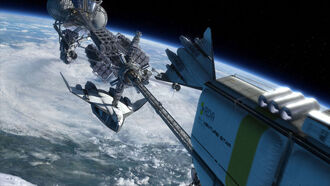
Venture Star in orbit over Pandora while one of the Valkyries is departing
- Three-axis triangulation from reference stars during cruise phase.[3]
- Radar ranging when in proximity to planets and satellites.[3]
- Synthetic-aperture side-looking radar for surface mapping purposes.[3]
Communications
Lightspeed
- Modulation of beamed power by ±0.1% for high bit-rate uplink during acceleration and deceleration phases.[3]
- Pulse-width modulated dedicated lasers for downlink and uplink when not using beamed power – bit rate dependent on distance.[3]
- Standard VHF/UHF radio for short-range communication between orbit and ground.[3]
Superluminal
- Very low bit-rate up- and downlink using McKinney quantum entanglement encoding.[8]
Life Support
All consumables are recycled to the maximum extent possible. Oxygen is reclaimed from carbon dioxide by fractional distillation of the ship’s atmosphere, which also removes all gaseous contaminants. Additionally, this process removes water vapor and purifies it for drinking. Steam distillation is used to reclaim more drinking water from urine and solid body waste. The dehydrated and sterilized remains are used as fertilizer in the hydroponic gardens, where fresh fruits and vegetables are grown to supplement the crew’s diet of freeze-dried food.[3]
An auxiliary atmospheric system provides a much larger amount of oxygen, and carbon dioxide removal, for the short periods when the vessel is in orbit around Earth or Pandora, and the passengers and full crew are not in cryosleep. It is not practical to maintain this condition for the duration of the voyage. In the event of a failure of the cryosleep system the passengers would be euthanized before awakening so that the crew can continue the mission and deliver the cargo. (The crew teams’ cryosleep system is separate, and triply-redundant.)[3]
Cargo
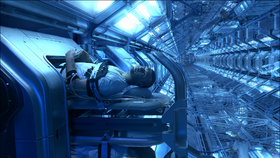
Jake Sully after waking up on the ISV Venture Star.
The ISV Venture Star is capable of carrying 350 tons of cargo. The cargo consists of triply backed-up blueprints for the Stereolithography plant, micro-miniaturized components like micro- and nanoprocessors and other circuitry elements that cannot be manufactured in the plant. The ship also carries two Valkyrie landing craft, 200 passengers in cryosleep, drugs and other medications that cannot be produced on site, Avatars and their amnio tanks.[3]
On the return to Earth the ISV Venture Star carries mainly refined unobtanium, but also small Na'vi artifacts to be sold as collectables to wealthy individuals for extremely high prices. Sometimes data containing the molecular structure of Pandoran organic compounds that may have medical or other applications on Earth are also transferred. The data will be used to synthesize them for testing and eventual sale back on Earth.[3] Samples of plants such as the puffball tree have also been brought back to Earth for further research. [9]
| See the image gallery for |
Trivia
- In the 1990s, the US contracted Lockheed Martin to develop a shuttle-esque spaceplane called VentureStar, also known as X-33. The project was cancelled in 2001 following failures.[10] The craft looked similar to the Valkyrie Shuttle.
Sources
- ↑ James Cameron's Avatar: An Activist Survival Guide p. 149
- ↑ AVATAR Scriptment pp. 6, 8
- ↑ 3.00 3.01 3.02 3.03 3.04 3.05 3.06 3.07 3.08 3.09 3.10 3.11 3.12 3.13 3.14 3.15 3.16 3.17 3.18 3.19 3.20 3.21 3.22 3.23 3.24 3.25 3.26 [1] ISV Venture Star
- ↑ Pandorapedia - RDA article
- ↑ Pandora ROVR opening cutscene, ingame articles for Drop Pod
- ↑ Alpha Centauri at Wikipedia
- ↑ No reference, see talk page
- ↑ James Cameron's Avatar: An Activist Survival Guide p. 156
- ↑ James Cameron's Avatar: The Game - Ingame Pandorapedia entry for Puffball Tree
- ↑ http://www.nasa.gov/centers/marshall/news/background/facts/x33.html